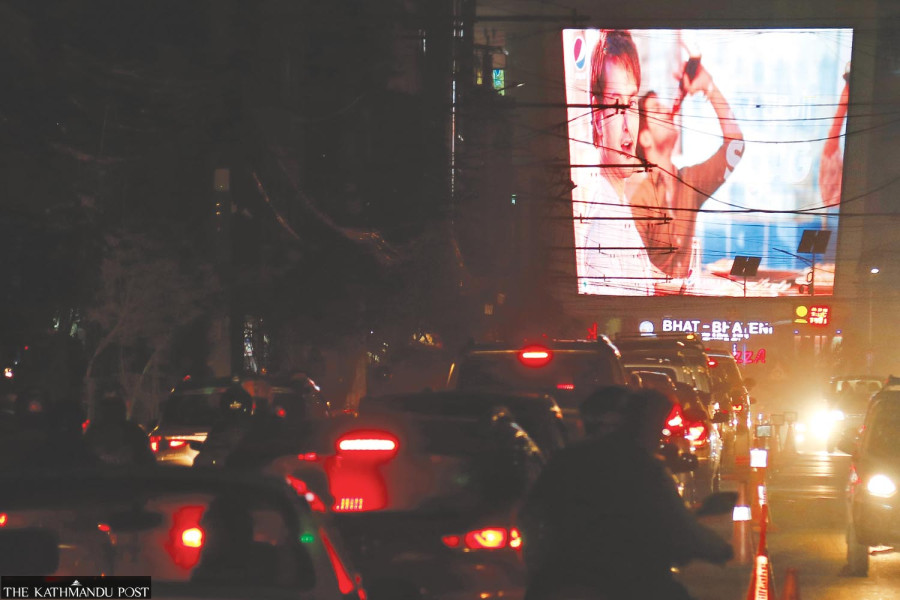Kathmandu
Kathmandu Metropolitan City slammed for lacking clarity on digital billboards
Last September, the City launched a crackdown on such billboards, but they have returned as a case is sub judice.
Anup Ojha
When the Kathmandu Metropolitan City in the first week of September announced its intentions to remove all illegally-installed digital advertisement boards from the City and switched off the digital billboard screen at the World Trade Centre at Tripureshwar as a starter of the drive, urban planners and heritage activists appreciated it.
City spokesman Nabin Manandhar told the Post at the time that it took action as the digital hoarding boards were installed without taking City’s permission. Similarly Shiva Raj Adhikari, the chief of the KMC’s Revenue Department said that the KMC was planning to remove all digital hoarding boards including those at Durbarmarg, Kathmandu’s high-end business district.
However, the City’s decision was not lasting. The digital screen at the United World Trade Centre at Tripureshwar came back into operation just after a few weeks, and some more bigger digital boards came into operation in Thapathali, Kalimati, Jadibuti, Koteshwar, Jamal and Durbarmarg areas.
“The crackdown did not last because of an immature decision by the City,” said Kishore Thapa, an urban planner and former government secretary.
“No one knows the actual policy on hoarding boards in Kathmandu,” said Thapa. He blamed the City for not making any clear laws regarding the visual boards, which, the traffic police say, are a factor in causing road accidents.
Adhikari, the chief of the KMC’s Revenue Department when asked why the City recanted from its earlier decision on digital hoarding boards, said the City could not take action as the issue is currently in the court. “The Patan High Court has given a stay order, that is why it could not take any action,” said Adhikari.
“Once the court’s verdict comes out, we will go for action,” he added.
According to officials at the City’s Revenue Department, only 49 digital boards have got permission from the City. “We have not kept a tab on the others, if they are installed, they are all illegal, and we will remove them,” said Adhikari.
Meanwhile, the City spokesperson Manandhar said the City only gives permission to digital boards covering less than 800 square feet. When asked how the new hoarding boards in Thapathali, Jamal and Koteshwar emerged, he didn’t have an answer.
“The KMC’s legislative committee is working on a draft for a separate law on hoarding boards or display boards. Once the new law comes out it will be easier for us to work,” said Manandhar.
Although the City could not keep its word on digital hoarding boards which it had earlier branded illegal and has also announced to remove them; it is aggressively removing small signboards at grocery stores, stationery shops, restaurants and other small businesses.
Shopkeepers complained they are being unfairly targeted.
“I don’t understand why the City is targeting the signboards at small shops when huge digital signboards and screens have been allowed to operate illegally,” said Asmita Khanal, 45, who runs a grocery shop at Dhobichaur. She said the board above her shop is not a billboard but a name board telling people about what kind of goods the shop deals with.
“They allow big billboards of big businesses because the City earns a lot of money from the boards. The authorities are biassed towards big businesses and are cracking down on smaller ones,” alleged Khanal.
According to KMC’s revenue department, it annually earns Rs50 million in revenue from digital hoarding boards.
It’s not only planners and heritage activists who see digital display boards as visual pollution in the historical city like Kathmandu, traffic police too have for long been expressing concerns over their impacts on riders, drivers and pedestrians.
“Digital hoarding boards distract drivers, and are one of the contributors to road accidents,” said Rajendra Prasad Bhatta, spokesperson at Kathmandu Valley Traffic Police Office.
“The bright lights of digital hoarding boards are great distractions in places where there are traffic lights,” said Bhatta.
The Advertising Board Promotional Material Regulation Policy 2013 of the KMC states that it is illegal to install commercial hoarding boards and advertising materials on additional frames on the rooftops, and balconies of private and public buildings.
In 2019, the KMC had announced plans to clear all hoarding boards from the streets, only allowing digital ones, but there was no monitoring.
Unhappy with the presence of visual pollutants around the city, senior advocate Padma Bahadur Shrestha had filed a writ petition in 2014 demanding removal of all such hoarding boards and digital screens from public places.
Responding to the petition, the Supreme Court had first issued an interim order to the local authorities and the government to make the city clean.
The final verdict, issued on September 2, 2015, ordered the authorities concerned to maintain the civilised appearance of the city and remove visual pollutants from core city areas. The court’s verdict, however, went unimplemented for a long time.




 16.57°C Kathmandu
16.57°C Kathmandu.jpg)










